Precision machining technology regulations that should be mastered
Jun 17,2020
Precision machining is a process of stopping changes to the shape dimensions or performance of a workpiece using machining equipment during the operation. Precision machining can be divided into cold processing and hot processing based on the temperature state of the workpiece being processed. Processing at room temperature that does not cause chemical or phase changes in the workpiece is called cold processing.

Precision machining is usually performed at temperatures above or below room temperature, which can directly cause chemical or phase changes in the workpiece, effectively referred to as hot processing. Cold processing can be further divided into cutting processing and pressure processing based on the method of processing. Common hot processing methods include heat treatment, forging, casting, and welding.
Precision machining mainly involves the process of changing the shape dimensions or functions of a workpiece through various machines. Based on the temperature conditions of the workpiece being processed, it is divided into cold processing and hot processing. In machining, a process refers to the series of technical processes completed continuously at a work location for one or a group of workpieces. The main characteristic of a process is that it does not change the processing objectives, equipment, and operators, and the content of the process is completed continuously. The technical processes can be divided into the following two processes.
The technical regulations for precision machining are one of the technical documents that specify the technical processes and operating methods for machining parts. It is written in a prescribed manner based on reasonable technical processes and operating methods under specific production conditions, and is used to guide production after approval. The technical regulations for machining usually include the following content: the technical route for workpiece processing, detailed content of each process and the equipment and technical configuration used, inspection items and methods for the workpiece, cutting amounts, time quotas, etc.
Precision parts processing technology refers to the modification of the shape, size, relative position, and properties of production objectives based on the process, turning them into finished or semi-finished products. It is a detailed description of each process and each flow, for example, rough processing may include blank manufacturing, grinding, etc., while finishing may be divided into turning, fitting, milling, etc.
Related dynamics
Contact Us
E-mail:tjjiaxuyan@163.com
Telephone:022-68976188,13821612718
Mobile:18902087888,13802191288
Address:Fengjia Village, Duliu Town, Jinghai District, Tianjin










